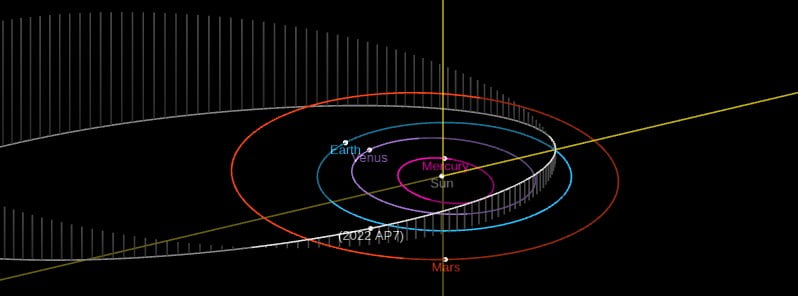Large potentially hazardous asteroid detected hiding in Sun’s glare – 2022 AP7

An international team of scientists reporting in The Astronomical Journal discovered a large Apollo-type near-Earth object (NEO) hiding in the Sun’s glare. Designated 2022 AP7 — this object has an estimated diameter between 1.1 and 2.3 km (0.7 – 1.4 miles), making it the largest Potentially Hazardous Asteroid (PHA) discovered in about eight years. The object is also in the top 5% of the largest PHAs known.
2022 AP7 was first observed at Cerro Tololo-DECam, Chile in the twilight on January 13, 2022.
It was recovered using DECam a few nights later on January 16, 2022, using the asteroid short-arc orbit and ephemeris computation program (known as KNOBS) written by Tholen & Whiteley. Recovery occurred again using DECam on the nights of January 18, 21, and 23.1
After recovery a few weeks later using the Las Cumbres telescopes and the University of Hawaii 88 inch telescope, 2022 AP7 was found in data from 2017 in both the NEO Pan-STARRS and Catalina Sky Survey images, when the object was last near opposition, though far from Earth and thus faint.
The orbit is thus very well known — based on an approximately 5-year observation arc.
2022 AP7 is an Apollo-type near-Earth object (NEO) that crosses Earth’s orbit with perihelion near 0.83 AU (124 million km / 77 million miles) and aphelion near Jupiter at 5.0 AU (748 million km / 464 million miles).
The Earth MOID for 2022 AP7 is only 0.0475 AU (710 590 km / 441 540 miles), making it a potentially hazardous asteroid and likely the largest PHA found since 2014 based on absolute magnitude.
2022 AP7 was relatively faint at discovery being 20.8 mag, but because it was relatively far from Earth at about 1.9 AU (284 million km / 176 million miles) and distant from the Sun around 1.4 AU (209 million km / 130 million miles). It is a fairly large object, likely being well over 1 km (0.6 miles) in size assuming a moderate albedo (1.0 – 2.3 km / 0.6 – 1.4 miles diameter for an albedo of 0.25–0.05, respectively), the authors said.
2022 AP7 was found as it approached perihelion, which is when cometary activity is expected to increase significantly.
No obvious coma or tail was detected in the discovery and recovery images.
The discovery of 2022 AP7 exemplifies how a relatively large telescope observing toward the Sun during twilight can find large NEOs that most of the current NEO surveys do not efficiently find. Many of the “missing” yet-to-be-found ∼1 km (0.6 miles) sized NEOs likely have orbits that alias with Earth, making them distant and faint when in the night sky at opposition like 2022 AP7.
References:
Asteroid 2022 AP7 at Minor Planet Center; at CNEOS
1 A Deep and Wide Twilight Survey for Asteroids Interior to Earth and Venus – Sheppard et al. – The Astronomical Journal – DOI: 10.3847/1538-3881/ac8cff – OPEN ACCESS
Featured image credit: CNEOS

Commenting rules and guidelines
We value the thoughts and opinions of our readers and welcome healthy discussions on our website. In order to maintain a respectful and positive community, we ask that all commenters follow these rules.